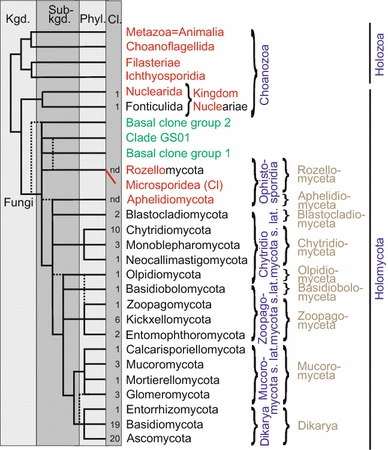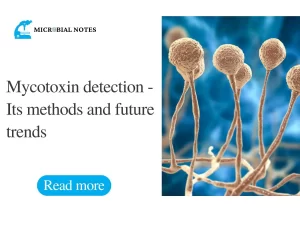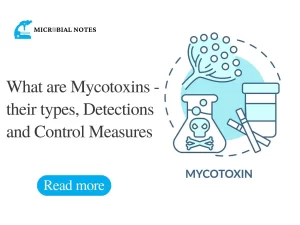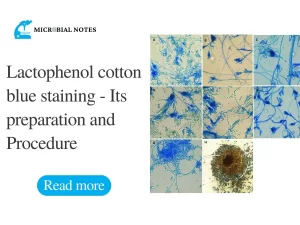Fungi are a diverse group of organisms that belong to the kingdom of Fungi. These are eukaryotic, non-photosynthetic creatures that take nourishment from their surroundings by absorbing organic materials. Fungi can live in many different places, including soil, water, plants, and animals.
Importance of fungal classification
Fungal classification is important for different reasons. First, it helps scientists learn more about how different groups of fungi have changed over time. This information can help researchers learn more about the roles fungi play in the environment and how they interact with other living things. Because some fungi species can be beneficial or harmful for crops and livestock. fungal classification is also important in agriculture and food production. Additionally, fungal classification has important medical implications, as certain fungi can cause serious infections in humans.
Historical overview of fungal classification
The classification of fungi has a long and complex history. Early attempts to classify fungi were based on their appearances, like the morphological structure of their fruiting bodies and spores. Around the middle of the 20th century, developments in molecular biology made it possible for scientists to use genetic information to improve the fungal classification. In the late 20th century, we learned how to sequence DNA, which has made it easier to group fungi based on their evolutionary relationships. In the modern era, morphological, ecological, and molecular data are combined to form the basis of fungal classification.
Major divisions of fungi
There are five main groups of fungi: the Chytridiomycota, the Zygomycota, the Ascomycota, the Basidiomycota, and the Glomeromycota. Each division is further broken down into classes, orders, families, and genera based on both physical and genetic traits. Every year, new groups of fungi are found and classified, making the classification of fungi a constantly evolving field of study.
Overview of the five major divisions of fungi:
Fungi are classified into five major divisions, each of which is characterized by distinct morphological and molecular features. These divisions are:
Chytridiomycota: Chytrids are primitive fungi characterized by their flagellated spores, which are unique among fungi. They are mostly aquatic and can be found in both freshwater and marine environments. Chytrids are also known to cause diseases in amphibians and are believed to have played a role in the decline of amphibian populations around the world.
Zygomycota: Zygomycetes are characterized by their production of zygosporangia, specialized structures that contain dormant spores. They are found in a wide range of habitats, including soil, decaying plant material, and animal dung. Some zygomycetes are used in food production, such as the mold used to make tempeh.
Ascomycota: Ascomycetes are characterized by their production of ascospores, which are contained within specialized sacs called asci. They are found in a wide range of habitats, including soil, water, and decaying plant material. Ascomycetes include many important plant pathogens, as well as edible fungi such as morels and truffles.
Basidiomycota: Basidiomycetes are characterized by their production of basidiospores, which are contained within specialized structures called basidia. They are found in a wide range of habitats, including soil, decaying plant material, and wood. Basidiomycetes include many important edible and medicinal fungi, such as mushrooms and bracket fungi.
Glomeromycota: Glomeromycetes are characterized by their formation of arbuscular mycorrhizae, specialized structures that allow them to form symbiotic relationships with plant roots. They are found in soil and play an important role in nutrient cycling and plant growth.
Characteristics of each division
Each division of fungi is characterized by its different morphological and molecular features. Chytrids, for example, are characterized by their flagellated spores and simple body structure, while basidiomycetes are characterized by their complex fruiting bodies and basidia. Ascomycetes and zygomycetes are characterized by their production of ascospores and zygosporangia, respectively. Glomeromycetes are unique among fungi in their ability to form arbuscular mycorrhizae.
Examples of fungi in each division:
Each division of fungi contains a diverse range of species. Some examples of fungi in each division include:
Chytridiomycota: Batrachochytrium dendrobatidis, a chytrid fungus that causes chytridiomycosis in amphibians.
Zygomycota: Rhizopus stolonifer, a common bread mold.
Ascomycota: Morchella esculenta, the edible morel mushroom.
Basidiomycota: Agaricus bisporus, the common white button mushroom.
Glomeromycota: Glomus intraradices, a species of arbuscular mycorrhizal fungi that forms symbiotic relationships with plant roots.
Fungal phylogeny
Fungal phylogeny is the study of the evolutionary history of fungi and their relationships to one another. In recent years, molecular methods have been used to understand the evolutionary relationships among fungi and to develop a more accurate and comprehensive classification system.
Molecular methods used in fungal phylogeny
One of the main molecular methods used in fungal phylogeny is DNA sequencing. This involves analyzing the sequence of nucleotides in the DNA of fungi and comparing them to sequences from other fungi. This can help identify similarities and differences between species and provide clues about their evolutionary history.
Another method is the use of molecular markers, such as ribosomal DNA (rDNA), which can be used to identify species and infer their phylogenetic relationships. Other markers that have been used include mitochondrial DNA (mtDNA), microsatellites, and single nucleotide polymorphisms (SNPs).
Major clades and subclades of fungi
Based on molecular studies, fungi have been classified into several major clades or groups. These include the Chytridiomycota, Zygomycota, Glomeromycota, Ascomycota, and Basidiomycota. These groups are further subdivided into subclades based on the molecular and morphological characteristics of fungi.
For example, Ascomycota is one of the largest and most diverse groups of fungi, and includes many well-known fungi such as morels, truffles, and yeasts. Within the Ascomycota, there are several subclades, including the Pezizomycotina, which includes many species of cup fungi, and the Saccharomycotina, which includes yeasts.

https://link.springer.com/article/10.1007/s13225-018-0401-0
Relationship between fungal phylogeny and classification:
The classification of fungi is based on their phylogenetic relationships, as determined by molecular and morphological studies. The goal of classification is to organize organisms into groups that reflect their evolutionary relationships and provide a useful framework for understanding their biology and ecology.
As molecular methods have become more advanced, the classification of fungi has become more complex and detailed. For example, the traditional division of fungi into the Ascomycota and Basidiomycota has been expanded to include several additional groups, such as the Chytridiomycota and Glomeromycota.
Classifying Fungi Based on Morphology and Reproduction
Fungi can be classified based on various reproductive characteristics. Some of the commonly used methods for classification include the type of spores produced, morphology of the fruiting bodies, hyphae, and their growth patterns.
Classification based on the type of spores produced
Fungi produce different types of spores, which can be classified on the basis of their morphology and mode of formation. The most common types of spores produced by fungi include zygospores, ascospores, and basidiospores.
Zygospores are produced by fungi in the Zygomycota division and are formed by the fusion of two haploid nuclei from different mating types. Ascospores are produced by fungi in the Ascomycota division and are formed inside a sac-like structure called an ascus. Basidiospores are produced by fungi in the Basidiomycota division and are formed on the surface of a club-shaped structure called a basidium.
Classification based on fruiting body morphology
Fungi can also be classified on the basis of their morphology of fruiting bodies, which are structures that produce and disperse spores. Different groups of fungi produce different types of fruiting bodies, which can range from simple stalks to complex structures such as mushrooms and brackets.
For example, fungi in the Basidiomycota division typically produce fruiting bodies that are characterized by the presence of a cap or pileus and a stalk or stipe. The shape and size of the cap and the presence of features such as gills, pores, or teeth can be used to further classify these fungi into different groups.
Classification based on hyphal morphology and growth patterns
Fungi can also be classified based on the morphology of their hyphae, which are the branching filaments that make up the fungal body. Different groups of fungi have different types of hyphae, which can vary in size, shape, and branching pattern.
For example, fungi in the Zygomycota division typically have hyphae that are coenocytic, meaning that they lack cross-walls or septa. Fungi in the Ascomycota and Basidiomycota divisions, on the other hand, typically have hyphae that are septate, meaning that they are divided into compartments by cross-walls.
In addition to hyphal morphology, the growth patterns of fungi can also be used for classification. Some fungi grow as molds, which produce fuzzy, filamentous colonies on surfaces. Other fungi grow as yeasts, which are single-celled organisms that typically grow in liquid or semi-solid media.
Classifying Fungi Based on Ecological Roles
Fungi are found in a variety of ecological roles, ranging from decomposers to parasites. These roles can be used to classify fungi into different groups based on their ecological function. The major ecological roles of fungi include:
Decomposers: Fungi play a critical role in breaking down organic matter in the environment. They decompose dead plant and animal material, including wood, leaves, and other organic debris. Decomposer fungi are found in almost every ecosystem and play a vital role in nutrient cycling. They help to release nutrients from dead organic matter, making them available to other organisms.
Mutualists: Some fungi form mutualistic relationships with other organisms, including plants and animals. One of the most well-known mutualistic relationships involving fungi is mycorrhizae. Mycorrhizal fungi form a symbiotic relationship with the roots of plants, providing the plant with nutrients in exchange for carbohydrates produced by the plant. This relationship is beneficial for both the plant and the fungus.
Parasites: Fungi can also act as parasites, feeding on living organisms without killing them. Parasitic fungi can be found in a variety of hosts, including plants, animals, and other fungi. They can cause a range of symptoms, including stunting, wilting, and discoloration. Parasitic fungi can also weaken their hosts, making them more susceptible to other diseases and environmental stressors.
Pathogens: Some fungi are pathogenic, causing diseases in plants, animals, and humans. Pathogenic fungi can be transmitted through the air, soil, or direct contact with infected hosts. They can cause a range of symptoms, including skin rashes, respiratory problems, and organ damage. Some pathogenic fungi are also opportunistic, causing infections in individuals with weakened immune systems.
Challenges in Fungal Classification
Fungal classification is a challenging task due to the diversity and complexity of fungal life cycles and morphologies, as well as the lack of complete genome sequences for many fungi. In addition, there is an ongoing debate over the validity of certain taxonomic groups.
Diversity and complexity of fungal life cycles and morphologies: Fungi exhibit a wide range of morphologies and life cycles, which can make classification difficult. Fungi can exist as unicellular yeasts, multicellular molds, or as a combination of both forms. Some fungi have asexual and sexual reproductive phases, while others only have one or the other. The existence of different life cycles and morphologies makes it difficult to determine relationships between different fungal groups.
Lack of complete genome sequences for many fungi: Despite significant progress in fungal genomics, there are still many fungi with incomplete or unknown genome sequences. This can make it challenging to accurately classify these fungi and determine their evolutionary relationships. Additionally, some fungi have very large genomes that are difficult to sequence and analyze.
The debate over the validity of certain taxonomic groups: There is an ongoing debate over the validity of certain taxonomic groups, such as the traditional classification of fungi into phyla. Some researchers argue that the traditional classification system is based on outdated and inadequate morphological criteria and that a new classification system based on molecular data is needed. Others argue that morphology still plays an important role in fungal classification and that a purely molecular classification system is incomplete.
References
- Alexopoulos, C.J., Mims, C.W., & Blackwell, M. Introductory Mycology. John Wiley & Sons, Inc.
James, T.Y., Kauff, F., Schoch, C.L., Matheny, P.B., Hofstetter, V., Cox, C.J., … & Hibbett, D.S.. Reconstructing the early evolution of Fungi using a six-gene phylogeny. Nature, 443(7113), 818-822. - Kirk, P.M., Cannon, P.F., Minter, D.W., & Stalpers, J.A. Dictionary of the Fungi (10th ed.). CAB International.
- James, T.Y., Pelin, A., Bonen, L., Ahrendt, S., Sain, D., Corradi, N., & Stajich, J.E. (2013). Shared signatures of parasitism and phylogenomics unite Cryptomycota and Microsporidia. Current Biology, 23(16), 1548-1553.
- Lücking, R. Fungal diversity in the 21st century: the potential of Fungi Online. Mycological Research, 112(10), 1157-1170.
- Hibbett, D.S., Binder, M., Bischoff, J.F., Blackwell, M., Cannon, P.F., Eriksson, O.E., … & Kirk, P.M. A higher-level phylogenetic classification of the Fungi. Mycological Research, 111(5), 509-547.
- Schoch, C.L., Sung, G.H., López-Giráldez, F., Townsend, J.P., Miadlikowska, J., Hofstetter, V., … & Spatafora, J.W. The Ascomycota tree of life: a phylum-wide phylogeny clarifies the origin and evolution of fundamental reproductive and ecological traits. Systematic Biology, 58(2), 224-239.
- Taylor, J.W., Berbee, M.L., & Mueller, G.M. Ascomycota: the fungal phylum that contains the largest number of plant symbionts. In Symbiosis (pp. 343-364). Springer, Dordrecht.
- Tedersoo, L., May, T.W., & Smith, M.E. Ectomycorrhizal lifestyle in fungi: global diversity, distribution, and evolution of phylogenetic lineages. Mycorrhiza, 20(4), 217-263.
- Bennett, J.W., & Klich, M. Mycotoxins. Clinical microbiology reviews, 16(3), 497-516.
- Tedersoo, L., Sánchez-Ramírez, S., Kõljalg, U., Bahram, M., Döring, M., Schigel, D., May, T., Ryberg, M., & Abarenkov, K. (2018, May 16). High-level classification of the fungi and a tool for evolutionary ecological analyses – fungal diversity.
- SpringerLink. Retrieved February 19, 2023, from https://link.springer.com/article/10.1007/s13225-018-0401-0







